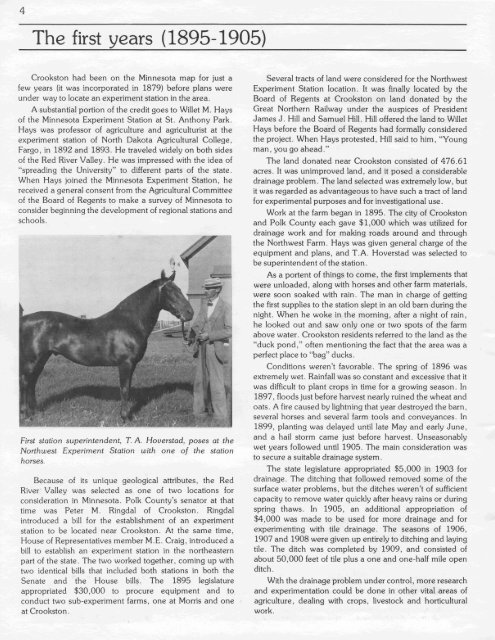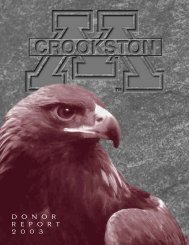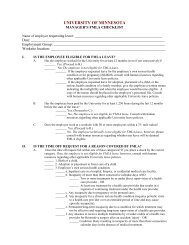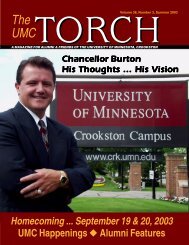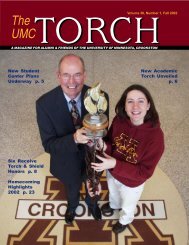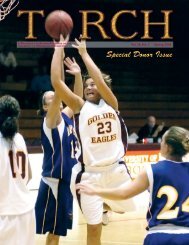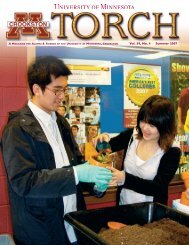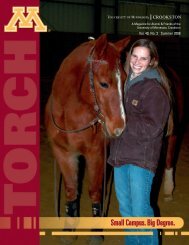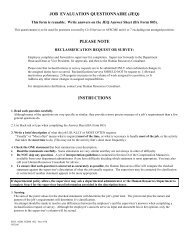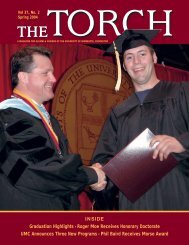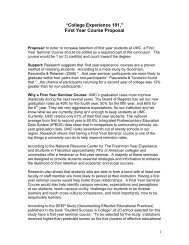Cycle - University of Minnesota, Crookston
Cycle - University of Minnesota, Crookston
Cycle - University of Minnesota, Crookston
Create successful ePaper yourself
Turn your PDF publications into a flip-book with our unique Google optimized e-Paper software.
4The first years (1895-1905)<strong>Crookston</strong> had been on the <strong>Minnesota</strong> map for just afew years (it was incorporated in 1879) before plans wereunder way to locate an experiment station in the area.A substantial portion <strong>of</strong> the credit goes to WiIlet M. Hays<strong>of</strong> the <strong>Minnesota</strong> Experiment Station at St. Anthony Park.Hays was pr<strong>of</strong>essor <strong>of</strong> agriculture and agriculturist at theexperiment station <strong>of</strong> North Dakota Agricultural College,Fargo, in 1892 and 1893. He traveled widely on both sides<strong>of</strong> the Red River Valley. He was impressed with the idea <strong>of</strong>"spreading the <strong>University</strong>" to different parts <strong>of</strong> the state.When Hays joined the <strong>Minnesota</strong> Experiment Station, hereceived a general consent from the Agricultural Committee<strong>of</strong> the Board <strong>of</strong> Regents to make a survey <strong>of</strong> <strong>Minnesota</strong> toconsider beginning the development <strong>of</strong> regional stations andschools.First station superintendent, T. A. Hoverstad, poses at theNorthwest Experiment Station with one <strong>of</strong> the stationhorses.Because <strong>of</strong> its unique geological attributes, the RedRiver Valley was selected as one <strong>of</strong> two locations forconsideration in <strong>Minnesota</strong>. Polk County's senator at thattime was Peter M. Ringdal <strong>of</strong> <strong>Crookston</strong>. Ringdalintroduced a biIl for the establishment <strong>of</strong> an experimentstation to be located near <strong>Crookston</strong>. At the same time,House <strong>of</strong> Representatives member M.E. Craig, introduced abiIl to establish an experiment station in the northeasternpart <strong>of</strong> the state. The two worked together, coming up withtwo identical biIls that included both stations in both theSenate and the House bills. The 1895 legislatureappropriated $30,000 to procure equipment and toconduct two sub-experiment farms, one at Morris and oneat <strong>Crookston</strong>.Several tracts <strong>of</strong> land were considered for the NorthwestExperiment Station location. It was finally located by theBoard <strong>of</strong> Regents at <strong>Crookston</strong> on land donated by theGreat Northern Railway under the auspices <strong>of</strong> PresidentJames J. HiIl and Samuel Hill. Hill <strong>of</strong>fered the land to WiIletHays before the Board <strong>of</strong> Regents had formally consideredthe project. When Hays protested, HiIl said to him, "Youngman, you go ahead."The land donated near <strong>Crookston</strong> consisted <strong>of</strong> 476.61acres. It was unimproved land, and it posed a considerabledrainage problem. The land selected was extremely low, butit was regarded as advantageous to have such a tract <strong>of</strong> landfor experimental purposes and for investigational use.Work at the farm began in 1895. The city <strong>of</strong> <strong>Crookston</strong>and Polk County each gave $1,000 which was utilized fordrainage work and for making roads around and throughthe Northwest Farm. Hays was given gene'ral charge <strong>of</strong> theequipment and plans, and T.A. Hoverstad was selected tobe superintendent <strong>of</strong> the station.As a portent <strong>of</strong> things to come, the first implements thatwere unloaded, along with horses and other farm materials,were soon soaked with rain. The man in charge <strong>of</strong> gettingthe first supplies to the station slept in an old barn during thenight. When he woke in the morning, after a night <strong>of</strong> rain,he looked out and saw only one or two spots <strong>of</strong> the farmabove water. <strong>Crookston</strong> residents referred to the land as the"duck pond," <strong>of</strong>ten mentioning the fact that the area was aperfect place to "bag" ducks.Conditions weren't favorable. The spring <strong>of</strong> 1896 wasextremely wet. Rainfall was so constant and excessive that itwas difficult to plant crops in time for a growing season. In1897, floods just before harvest nearly ruined the wheat andoats. A fire caused by lightning that year destroyed the barn,several horses and several farm tools and conveyances. In1899, planting was delayed until late May and early June,and a hail storm came just before harvest. Unseasonablywet years followed until 1905. The main consideration wasto secure a suitable drainage system.The state legislature appropriated $5,000 in 1903 fordrainage. The ditching that followed removed some <strong>of</strong> thesurface water problems, but the ditches weren't <strong>of</strong> sufficientcapacity to remove water quickly after heavy rains or duringspring thaws. In 1905, an additional appropriation <strong>of</strong>$4,000 was made to be used for more drainage and forexperimenting with tile drainage. The seasons <strong>of</strong> 1906,1907 and 1908 were given up entirely to ditching and layingtile. The ditch was completed by 1909, and consisted <strong>of</strong>about 50,000 feet <strong>of</strong> tile plus a one and one-half mile openditch.With the drainage problem under control, more researchand experimentation could be done in other vital areas <strong>of</strong>agriculture, dealing with crops, livestock and horticulturalwork.


